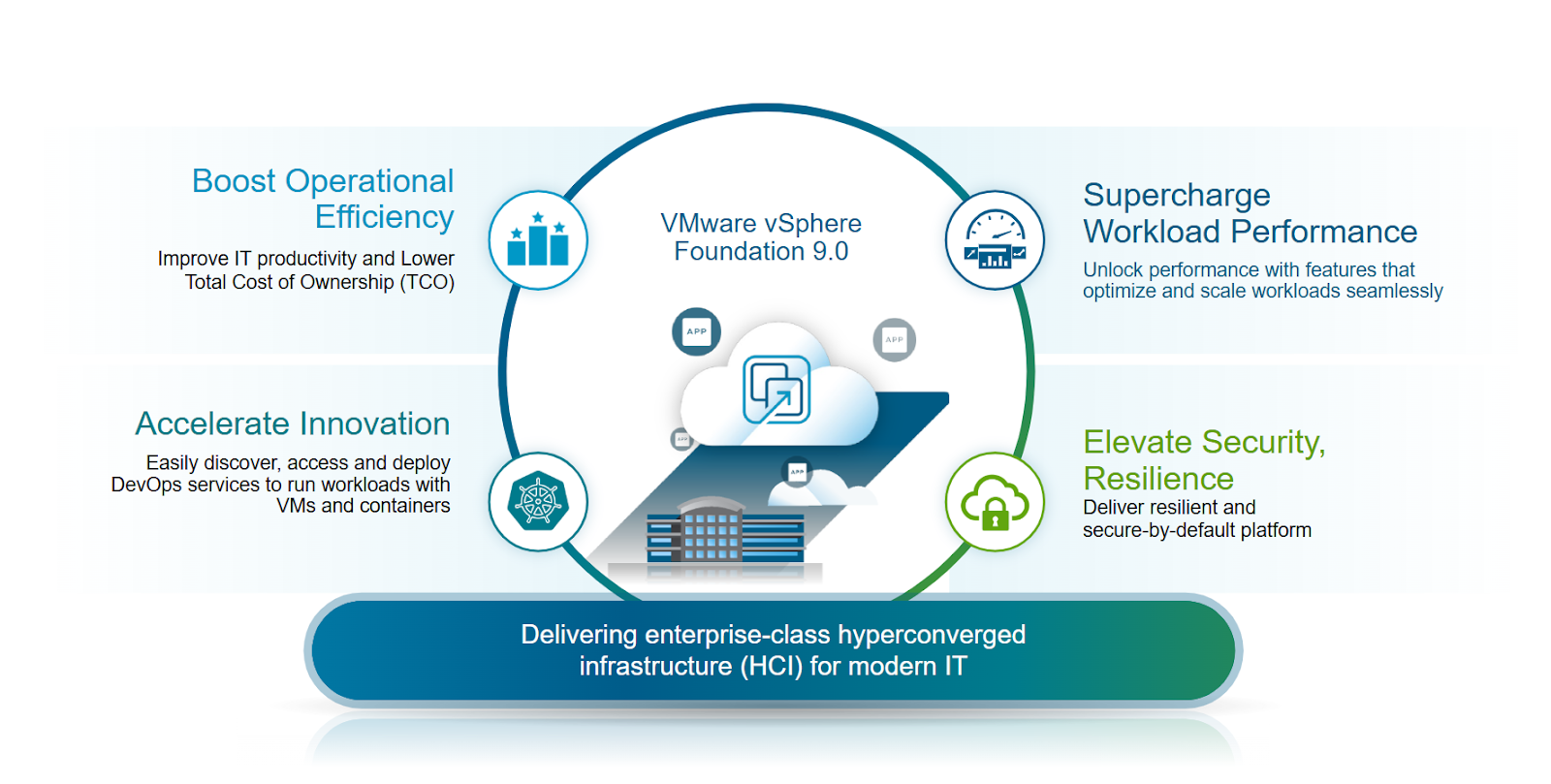Broadcom has just announced the General Availability (GA) of VMware Cloud Foundation (VCF) 9.0, the platform for the modern private cloud. And also has just announced the General Availability (GA) of VMware vSphere Foundation (VVF) 9.0.
Currently, vSphere 9.0 features are only available as part of VMware vSphere Foundation 9.0 and VMware Cloud Foundation 9.0. There is not yet an independent VMware vSphere 9.0 version.
Note that the new products are already in GA… seems that for version 9.0 Broadcom is not using the VMware vSphere 8.0 IA/GA release model.
VCF and VVF 9.0 deliver a single unified platform that supports all applications—traditional, modern, or AI—with consistent operations, governance, and controls across the private cloud environment. With VCF and VVF 9.0, customers benefit from a modern private cloud that:
- Accelerates innovation with out-of-box self-service offerings and a consistent experience that frees development teams to focus on applications instead of infrastructure.
- Controls cost through deep visibility and insights into resource usage that allow better planning, predicting, and optimization of cloud spend.
- Enables sovereignty and security with data control that supports better compliance, cyber resilience at scale and fleet-level management that helps ensure the latest patches are applied quickly, security controls are up to date, and policy compliance continues.

What’s new in VCF and VVF 9.0?
VMware Cloud Foundation Installer
Simplify VMware vSphere Foundation setup with a new guided, automated installation experience. The new VMware Cloud Foundation Installer, automates pre-checks and configuration, ensuring each component of VMware vSphere Foundation is deployed correctly.
Want to spin up identical environments across clusters or sites? Simply reference a JSON template to replicate environments across clusters or sites, ideal for consistent rollouts.
VCF Installer delivers the following key benefits to VMware vSphere Foundation:
- Eliminates manual installation steps, reducing deployment complexity.
- Minimizes configuration errors through embedded health checks.
- Speeds time to production so admins can focus on strategic projects.
Advanced Memory Tiering with NVMe
RAM can be a significant cost in the data center. VMware vSphere 8.0 Update 3 introduces NVMe memory tiering in tech preview for automatically moving cold or infrequently accessed memory pages to high-performance NVMe SSDs while keeping hot pages in DRAM. The result is a larger effective memory footprint at a fraction of the cost. Ideal for memory intensive environments such as VDI (Virtual Desktop Infrastructure). Now it’s available in GA.
Advanced Memory Tiering with NVMe delivers the following key benefits:
- Increases workload density, consolidating more VMs per host.
- Reduces DRAM requirements, lowering hardware, power, and cooling expenses.
- Achieve up to 38% lower memory & server TCO (Total Cost of Ownership).
vSphere Lifecycle Management (vLCM) Enhancements
VMware vSphere Lifecycle Manager (vLCM) now supports composite cluster images, allowing customers to manage mixed vendor clusters with multiple server models and hardware types in a single cluster. Up to four additional image configurations per cluster can be defined per cluster, each with its own unique vendor add-ons, firmware, and hardware support managers (HSMs), while maintaining a consistent ESX base version.
This enhancement gives IT teams the flexibility to scale and modernize infrastructure without hardware lock-in, simplifies lifecycle management, and ensures consistent, compliant updates across diverse environments.
vLCM enhancements delivers key benefits:
- Uniform patch workflows ensure compliance and maximize uptime.
- Simplifies maintenance windows by reducing patch driven surprises.
- Flexible hardware expansion allows adding new server models to existing clusters without full hardware refreshes or rearchitecting.
Enhanced Unified Storage Dashboard for Holistic Visibility
VMware vSphere Foundation consolidates telemetry from core infrastructure into a single control plane. In VMware vSphere Foundation 9.0 an enhanced unified storage dashboard delivers real-time visibility into vSAN, SAN, and NAS environments—eliminating the need for multiple monitoring tools. Built-in machine learning analytics and intelligent alerts help detect anomalies early, while integrated diagnostics streamline root cause analysis.
Enhanced support for vSAN/HCI performance diagnostics enables users to run targeted performance tests on clusters, with actionable insights and recommendations to quickly identify and resolve performance issues.
Enhanced unified storage dashboard delivers the following key benefits:
- Unified view across all storage types, eliminating the need to switch between multiple consoles.
- Live health and performance metrics for faster issue detection and troubleshooting.
- Predictive insights help prevent downtime and improve SLAs.
Faster migration for GPU with 6x faster vMotion
AI/ML workloads demand uninterrupted GPU access and any pause can derail training or inference. VMware vSphere Foundation 9.0 accelerates vMotion for GPU-backed VMs by streaming GPU memory up using Fast Suspend/Resume. VMware vSphere Foundation 9.0 vMotion is now up to 6x faster for GPU powered workloads, resulting in zero downtime during VM lifecycle events running GPUs.

GPU vMotion optimization key benefits:
- Increased uptime for AI/ML workloads.
- Maintains near-peak performance during host maintenance.
- Ensures SLAs for GPU-driven applications remain intact.
Increase support for “Monster” VMs
VMware vSphere Foundation 9.0 raises the bar on VM scale, you can now configure a single VM with up to 960 CPUs, with native support for the latest AMD Zen 5 and Intel Granite Rapids processors. Whether you’re running in-memory databases, large-scale container platforms, or enterprise analytics, VMware vSphere Foundation 9.0 lets you consolidate these “monster” workloads onto a single host.
Support for “Monster” VMs key benefits:
- Simplifies capacity planning by reducing the need to share across servers.
- Enables large-scale workloads to run on a single host, cutting operational overhead.
- Provides performance gains from next-gen CPU architecture.
Traffic Separation for vSAN Storage Clusters
In VMware vSphere Foundation 9.0, vSAN storage cluster (formerly known as vSAN Max) traffic separation creates a dedicated network pipeline for storage operations. In testing across real-world workloads, this delivers more IOPS without new hardware. When a node fails, storage traffic remains isolated, providing predictable performance as your cluster scales.

vSAN storage clusters traffic separation delivers the following key benefits:
- Boost vSAN storage cluster performance by up to 25%.
- Reduces performance-related tickets and improves overall SLAs.
- Use existing investment for compute network traffic.
Deliver Asynchronous Supervisor Releases
In VMware vSphere Foundation, the vSphere Supervisor provides a control plane on which a robust set of services can be provisioned to support building modern workloads using containers and VMs. With today’s 9.0 release, Supervisor clusters can be patched and updated independently of vCenter. This allows for more rapid delivery of new Supervisor versions and access to the newest functionality and security patches

Asynchronous Supervisor Releases deliver the following key benefits:
- Faster delivery of Supervisor releases and new functionality.
- Non-disruptive operations, update the Supervisor independently of vCenter.
- Flexible update options, choose between Broadcom depot or offline Content Library.
Open API 3.0 and Unified SDK
Standardized APIs and consistent SDKs across VMware vSphere Foundation components. Open API 3.0 support for vCenter and vSAN APIs. Deliver a consistent automation experience across all VMware vSphere Foundation components. Make automation of services easy and simplify initial setup and configuration for developers to use these APIs and SDKs. Enable support of legacy and new applications to access these services.
Automation with Open API 3.0 and Unified SDK key benefits:
- Unified automation, one SDK and OpenAPI 3.0 simplify provisioning operations across VMware vSphere Foundation.
- Accelerate automation with scripts that continue working across upgrades, enabled by Open API specs and seamless SDK regeneration.
- Enable effortless expansion to VMware Cloud Foundation by extending without learning new APIs.
vSAN to vSAN Replication
New data protection workflows are now built into vSAN Express Storage Architecture (ESA), eliminating the need for separate replication tools. With VMware vSphere Foundation 9.0, you can use vSAN data protection workflows to replicate snapshots asynchronously between two vSAN ESA datastores. This integrated vSAN-to-vSAN replication allows you to define and manage recovery policies directly within the vSAN cluster, using immutable snapshots and VM-level replication, without requiring additional infrastructure or matching hardware at both sites.

vSAN-to-vSAN replication delivers the following key benefits:
- Simplified operations with policy-based protection. Easily assign protection policies via protection groups to one or multiple VMs.
- Achieve rapid and efficient recovery to minimize data loss and downtime during site-level failures with near-continuous protection.
- Built-in resilience, ensures critical workloads remain available with integrated, VM-level failover and failback capabilities.
TLS 1.3 by default
VMware vSphere Foundation 9.0 ships with TLS 1.3 enabled on all management and API endpoints. By enforcing only AEAD (Authenticated Encryption and Associated Data) ciphers and forward secrecy by default, it eliminates legacy protocols, compliance is automatic. This also cuts setup time compared to TLS 1.2 and delivers faster, more responsive HTTPS connections, while protecting each session with a unique encryption key.

Secure by default with TLS 1.3 enabled key benefits:
- Modern encryption standards reduce attack surface and simplify audits.
- FIPS 140-2 validated encryption gives you enterprise-grade trust.
- Administrators can roll out secure communications quickly across the infrastructure.
Agile security with Live Patching
VMware vSphere Foundation 9.0 expands on the Live Patching capability first introduced in VMware vSphere 8.0 Update 3, enabling faster response to security threats without impacting your operations. Whether it’s the ESX host, vSAN, or the core vmkernel, these essential updates are delivered within a defined SLA, ensuring your infrastructure remains compliant and secure—without the downtime.
Security Live Patching for ESX key benefits:
- Apply critical patches, no need to reboot or evacuate VMs, keep workloads running.
- Fast remediation with express patches, rapid delivery of security fixes within a defined SLA.
- Built-in UI guidance for safe operations, helps troubleshoot issues or switch to maintenance mode if needed.












